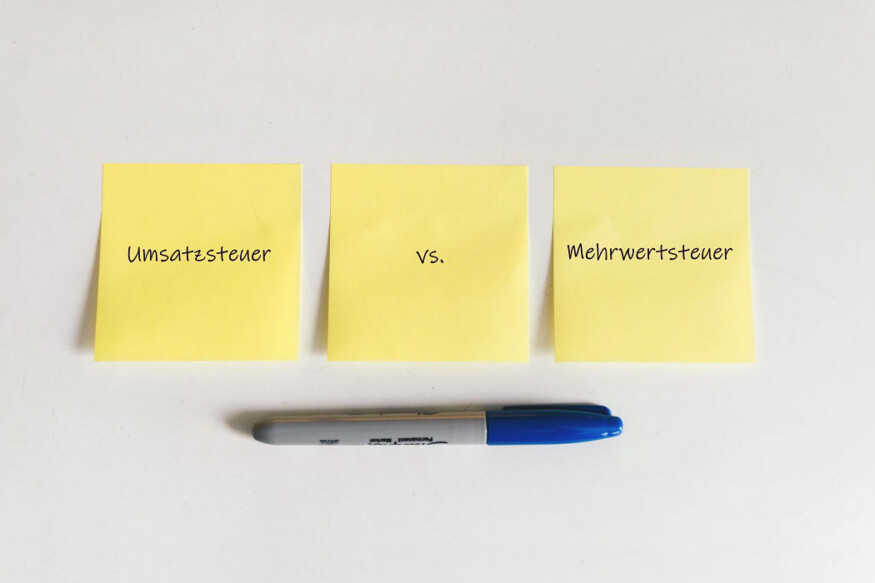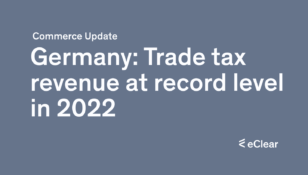The German terms “Mehrwertsteuer” (value-added tax) and “Umsatzsteuer” (turnover tax) are – incorrectly – used synonymously by consumers. From a commercial perspective and by law, the only valid terms are “Umsatzsteuer” and “Vorsteuer” (input tax).
Mehrwertsteuer, Umsatzsteuer and Vorsteuer in a nutshell
- The “Mehrwertsteuer” (VAT) that a business enterprise shows on an invoice is the “Umsatzsteuer” or turnover tax
- The “Mehrwertsteuer” (VAT) that a business pays on its purchases is the input tax (“Vorsteuer”)
- The input tax (“Vorsteuer”) is deducted from the turnover tax (“Umsatzsteuer”) in the VAT return
- The “Mehrwertsteuer” (VAT) is paid in full solely by the private consumer
The “Umsatzsteuer” (turnover tax) is added as a percentage to the net value, i.e.: net + turnover tax = gross price
Example: A leather goods manufacturer sells a bag for €100 net plus 19% “Umsatzsteuer” or “USt.” (turnover tax) to a wholesaler. Selling price: €119. The wholesaler declares the €19 as input tax to the tax office to be able to deduct this amount later. The wholesaler sells the bag for €150 to a retail store and charges €150 plus 19% “Mehrwertsteuer” (VAT) (€28.50) = €178.50. The wholesaler deducts the input tax of €19 from the purchase of the bag from the €28.50 “Umsatzsteuer” and ultimately pays €9.50 in tax to the tax office.
The commercial enterprise therefore only pays tax on its added value of €50 from the proceeds of the sale, which explains the term “Mehrwertsteuer” or value-added tax.
Defining the differences
Only the consumer who buys the product pays the full tax on a one-time basis. The business enterprise or seller adds the tax to the net amount of the sale and refers to this as “Umsatzsteuer (USt.)” or turnover tax. He collects this tax, but it is only a transitory item because the amount must be forwarded to the tax office. This tax is one of the most important sources of income for the state.
The “Umsatzsteuer” or turnover tax on goods and services purchased by the business enterprise is called “Vorsteuer (VSt.)” or input tax. He can deduct the input tax he has paid from the “Umsatzsteuer” he collects and pays to the tax office. He thus offsets the tax revenues and expenses.
What is the ‘added value’?
Only end users or consumers are required to pay the full “Umsatzsteuer”. They pay for the “added value”. A business enterprise can deduct the “Umsatzsteuer” or turnover tax paid on commercial purchases as input tax. The tax law for this principle is known as the “net all-phase system with input tax deduction”.
History of “Umsatzsteuer” (turnover tax) in Germany
Until 1967, a minimal tax of 4% was levied each time goods were resold in Germany. This tax was cumulative, and the goods became slightly pricier with each transaction. The current one-time “Umsatzsteuer” or turnover tax was introduced at the beginning of 1968. Since then, the consumer has been required to pay the full tax amount on a one-time basis.
When the tax was introduced in 1968, the standard rate was 10%. A reduced rate of 5% applied to goods for everyday consumption. The first increase, to 11% (5.5% for everyday consumer goods), went into force in 1968. Five more increases of the standard rate by one percentage point, each, followed until 1998. The reduced rate has remained unchanged at 7% since 1983.
“No Merkel tax!” was the slogan used by Germany’s SPD political party to campaign against a tax increase in 2005. But the CDU/CSU party prevailed in the coalition pact, and it was agreed to raise the standard rate from 16% to 19% from 2007 onwards. To boost consumption during the Covid-19 crisis, the German federal government temporarily lowered the standard rate to 16% for the second half of 2020. The rate returned to 19% again on January 1, 2021.
At 19%, Germany ranks at the lower end of the standard rates in the EU. Most countries charge more than 20%. Hungary charges the highest VAT at 27%, Luxembourg the lowest at 17%.
What does the reduced tax rate apply to?
The reduced rate of 7% applies to goods and services that include the following:
- Passenger transport by railway, cableway or taxis
- Tickets for theatres, concerts, or museums
- Services provided by health resorts
- Livestock and crop farming
- Dental technician services
- Hotel rooms/overnight stays
The reduced tax rate for hotel rooms and overnight stays has only been in effect for a few years. This leads to the peculiarity that two VAT amounts are listed on hotel invoices: 7% for the overnight stay and 19% for breakfast or other meals.
What are some things not subject to “Umsatzsteuer”?
Among others, credit mediation, insurance services, real estate sales, rentals and leases, medical and nursing services, ambulance services, school and educational services, intra-Community supplies and deliveries abroad are exempt from “Umsatzsteuer” (turnover tax).
Who is required to pay “Umsatzsteuer” (turnover tax)?
This tax obligation applies to all commercial enterprises, as well as to self-employed persons, such as individual traders or freelancers, who are not subject to business tax (“Gewerbesteuer”). They are required to add “Umsatzsteuer” to all their sales, show the amount on the invoice, and declare it to the tax office. Since this tax is a transitory item, the business does not benefit from it – but incurs extra work when it comes to the advance VAT return and VAT return.
Is it permissible to put “Mehrwertsteuer” on the invoice instead of “Umsatzsteuer”?
In Germany and Austria, the correct term is “Umsatzsteuer” (turnover tax) – especially since the word “Mehrwertsteuer” (value-added tax) does not exist in tax law or legislation. Strictly speaking, the use of the wrong term on invoices could render the input tax deduction invalid. However, no tax office has, in fact, demanded corrections to submitted outgoing or incoming invoices. Therefore, invoices already issued and submitted with the term “Mehrwertsteuer” (VAT) do not need to be corrected. Nevertheless, experts recommend that business enterprises use the term “Umsatzsteuer” on their invoices.
What is the tax called in countries outside of Germany?
The term “Mehrwertsteuer” is common in Germany and countries where the net all-phase system with input tax deduction applies. It is also legally valid in Switzerland. The designations in other countries are similar and can be translated as “value-added tax”.
- VAT or “value added tax” is common in many English-speaking countries, including the United Kingdom, Ireland, the USA and South Africa, India and Israel*) and in international communications
- TVA or “taxe sur la valeur ajoutée” is used in France
- IVA or “imposta sul valore aggiunto” applies in Italy and “impuesto al valor agregado” in Spain and in many Spanish-speaking countries
- MOMS or “meromsætningsafgift” is used in Denmark, “mervärdes- och OMSättningsskatt” in Sweden, and MVA or “merverdiavgift” in Norway
In Austria, the legally correct term is the same as in Germany: “Umsatzsteuer.”
Other terms include the following:
- GST or “goods and services tax” in Australia, Canada, New Zealand
- Consumption tax (消費税, shōhizei) in Japan*)
- PTU or “podatek od towarów i usług” (tax on goods and services) in Poland, although the international abbreviation VAT is commonly used
- BTW, or “belasting over de toegevoegde waarde” in the Netherlands
*) Source: Wikipedia
Who is not required to charge “Umsatzsteuer” (turnover tax)?
In Germany, self-employed persons can apply to the tax office for the small business regulation. This is granted if sales in the previous calendar year were below €22,000 and are expected to remain below €50,000 in the current year. The “Umsatzsteuer” or turnover tax obligation does not apply with the small business regulation. A self-employed person can offer goods and services at the net price.
A self-employed person gains a competitive advantage through potentially lower end-user prices. The work involved in filing VAT tax returns is also eliminated. The disadvantages: a small business owner and his commercial customers cannot deduct input tax. If annual sales exceed the small business limit, the business enterprise must add on the tax and risks losing customers when its services become pricier.
Intra-Community supplies are also exempt from “Umsatzsteuer” (turnover tax) in the supplier’s country. Intra-Community supplies refer to goods or services provided to recipients in another EU country. These must be registered with the tax office and declared accordingly on the invoices – including the VAT identity numbers of the sender and recipient. Only the net price is invoiced.
Where do special turnover taxes (Umsatzsteuer) apply?
In addition to domestic sales of goods and services, the following are subject to Umsatzsteuer:
- Imports from third countries (non-EU)
- Intra-Community purchases from EU countries
Imports from third countries that are not EU Member States are subject to import VAT. This tax must be paid by both private and commercial recipients. The respective domestic tax rate of the recipient country applies; this is usually 19% in Germany.
Intra-Community purchases means that the recipient is a commercial customer and receives goods from another EU country. These purchases are taxable only in the country of the recipient, not the sender. The turnover tax rate of the recipient country applies, and the sum can be claimed as input tax.
Conclusion: The term “Mehrwertsteuer” (value-added tax) is commonly used in Germany and Austria. However, the correct term is “Umsatzsteuer” (turnover tax). Only the end customer is required to pay this tax in full. Companies must show it on the invoice and pay it to the tax office. It is therefore a transitory item. The “Umsatzsteuer” (turnover tax) that a company pays on purchases is referred to as “Vorsteuer” or input tax and can be deducted from the turnover tax payment to the tax office.
Let’s stay in touch!
Stay up to date on the latest market trends, best practices and regulatory changes affecting cross-border trade by following us on LinkedIn.








